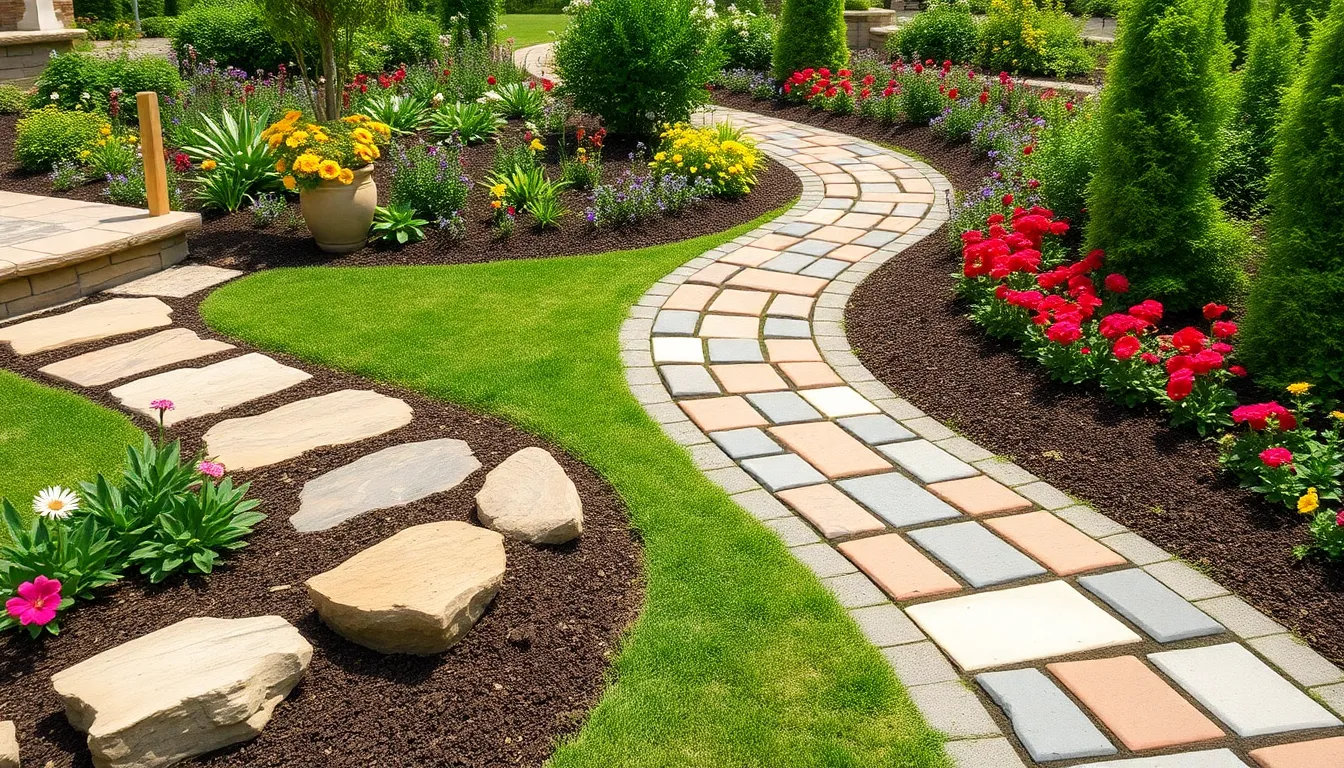Imagine strolling through a garden where each step feels like a mini adventure. Garden pathways aren’t just practical; they’re the secret ingredient that transforms a simple yard into a delightful escape. Whether it’s a winding stone path or a charming wooden boardwalk, these pathways invite exploration and add a touch of whimsy to any outdoor space.
But let’s face it: a garden without a pathway is like a cake without frosting—lacking that essential flair. Not only do they guide visitors through the beauty of blooms, but they also keep muddy shoes at bay. So why not take a moment to discover how the right pathway can elevate your garden game? Get ready to dig into the delightful world of garden pathways and learn how to create a space that’s as inviting as it is enchanting.
Table of Contents
ToggleOverview of Garden Pathways
Garden pathways serve as vital components that enhance both aesthetics and function in outdoor spaces. Different materials, such as gravel, brick, and limestone, offer unique visual appeal and durability. Pathways direct foot traffic, reducing wear on grass and garden beds. Their structure provides a means of access, ensuring visitors can explore without disturbing plant life.
Design varies widely; straight paths offer a formal look, while curved paths create a more relaxed atmosphere. Lighting plays a significant role in the ambiance, making pathways inviting during dusk and nighttime. Incorporating plants along the edges softens the hardscape, adding beauty and visual interest.
Layout impacts perception. A well-planned pathway can draw attention to specific garden features or encourage deeper exploration. Multi-functional pathways serve as access points while providing seating areas or gathering spots. Select materials that resonate with the overall garden theme for a cohesive look.
Durability is crucial; pathways must withstand weather and foot traffic. Regular maintenance ensures pathways remain functional and appealing. Cleaning debris and repairing cracks keeps the space inviting and safe. Different textures can enhance the sensory experience, making pathways more engaging.
Incorporating artistic elements, such as mosaics or stepping stones, adds personality. Unique designs encourage creativity and can reflect the owner’s style. Safety should always be considered; even materials like wood require treatments to prevent slipping. Garden pathways transform spaces, guiding visitors while contributing to the landscape’s allure.
Types of Garden Pathways

Garden pathways come in various types to meet aesthetic and practical needs. Different materials can create unique atmospheres in any garden setting.
Natural Materials
Natural materials enhance the organic feel of a garden. Stone, wood, and gravel offer durability and blend seamlessly with nature. Flagstone provides a rustic charm with its unique shapes. Wooden planks or mulch create a warm, inviting pathway while promoting a natural look. Gravel pathways allow for easy drainage, making them practical for various climates. Each material can be complemented by plants or flowers along the edges, creating a cohesive appearance.
Man-Made Materials
Man-made materials also play a vital role in garden pathways. Concrete pavers offer flexibility in design and come in multiple colors. Bricks provide a classic touch with their timeless appeal. Interlocking tiles introduce geometric patterns, enhancing visual interest while ensuring stability. Asphalt options may offer low maintenance and budget-friendly alternatives. Synthetic materials, such as rubber or composites, can mimic the look of natural stones while providing durability. These pathways can contribute to overall garden aesthetics and functionality while ensuring pedestrian safety.
Designing Your Garden Pathway
Designing a garden pathway requires careful consideration of various factors to create an inviting and functional space.
Considerations for Location
Choosing the right location for a pathway influences its usability and aesthetic appeal. Assess the natural flow of foot traffic to determine the best route. Pathways should connect key areas, like entrances, seating, and garden features. Avoid positioning them directly under trees with falling leaves or debris, as maintenance becomes challenging. Take into account sunlight exposure, ensuring visibility and safety for evening strolls. Avoid steep slopes that may cause accessibility issues. Surveying the layout helps create a pathway that enhances the garden’s overall design while facilitating ease of movement.
Selecting the Right Materials
Selecting appropriate materials is vital for a pathway’s durability and visual appeal. Consider local weather conditions, as certain materials fare better in specific climates. Gravel offers an informal, rustic look and provides effective drainage. Brick pathways add charm and elegance to traditional gardens. Stone presents a timeless appeal, enhancing natural surroundings. Concrete pavers offer versatility, allowing for unique patterns and designs. Sustainability should guide material choices, prompting the use of recycled or eco-friendly options. Balancing aesthetics and functionality ultimately creates pathways that withstand the test of time while enhancing the garden’s beauty.
Maintenance of Garden Pathways
Maintaining garden pathways ensures their longevity and aesthetic appeal. Effective upkeep minimizes hazards and enhances the garden’s overall beauty.
Cleaning and Upkeep
Regular cleaning keeps pathways free from debris, dirt, and organic matter. Sweep pathways weekly to remove fallen leaves and dirt. Consider using a pressure washer to eliminate stubborn stains. For gravel paths, raking helps redistribute stones and maintains an even surface. Inspect for weeds regularly; pulling them out promptly prevents root establishment. Additionally, edging along pathways enhances definition and prevents grass encroachment.
Seasonal Care Tips
Adapting maintenance tasks according to the season promotes pathway integrity. During spring, prune adjacent plants for adequate light and air circulation. Summer activities include refreshing gravel by topping it up as needed. Fall means clearing fallen leaves to prevent decay and moisture buildup. In winter, apply salt or sand cautiously on ice-prone areas to maintain safety without damaging materials. Each seasonal task contributes to overall pathway health and visual appeal.
Enhancing Your Pathway Aesthetics
Creating inviting and visually appealing pathways involves thoughtful considerations. Integrating natural elements and effective lighting enriches the garden experience.
Plant Pairings and Accents
Incorporating plant pairings along pathways adds vibrancy and life. Choose colorful flowers that bloom at different times for continuous interest. Low-growing plants work well for bordering pathways, while taller species can frame areas and draw the eye. Consider using fragrant herbs like lavender or rosemary for sensory appeal. Adding ornamental grasses provides texture and movement, enhancing visual dynamics. Overall, these plant accents complement the pathway’s design and create inviting spaces.
Lighting Options
Using strategic lighting elevates beauty and safety in garden pathways. Pathway lights direct visitors along routes while illuminating features. Solar-powered lights offer an eco-friendly option and charge during the day. Lanterns can introduce a charming, whimsical feel, especially in evening settings. For more dramatic effects, consider uplighting on nearby trees or architectural elements, creating fascinating shadows. Properly placed lights enhance ambiance and encourage exploration.
Garden pathways serve as vital components of any outdoor space. They not only enhance the visual appeal but also improve functionality and safety. With a variety of materials and designs available, gardeners can create pathways that reflect their personal style while accommodating foot traffic and protecting delicate plants.
Regular maintenance ensures these pathways remain inviting and durable over time. By incorporating natural elements and strategic lighting, pathways can transform a garden into a captivating retreat. Ultimately, well-designed pathways invite exploration and appreciation of the beauty that lies within the garden.



